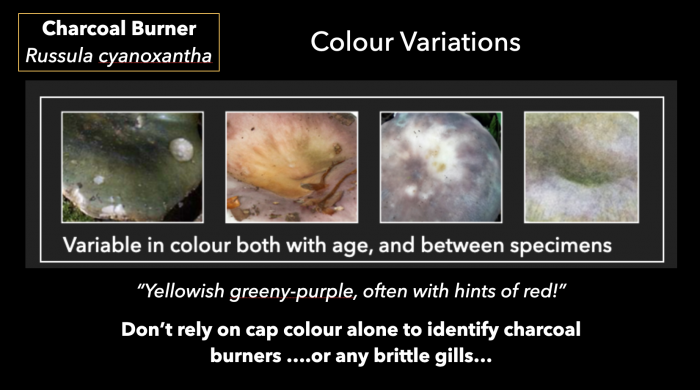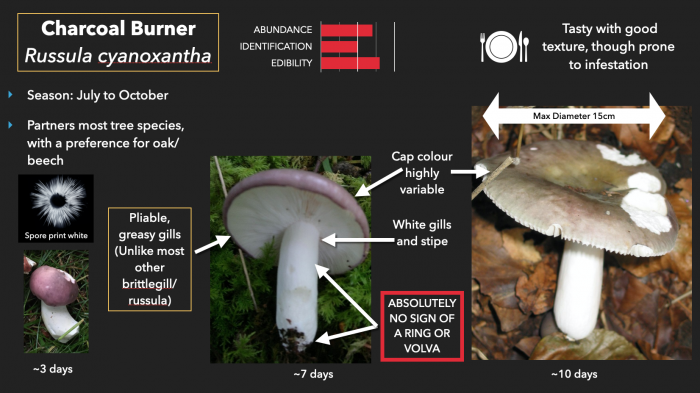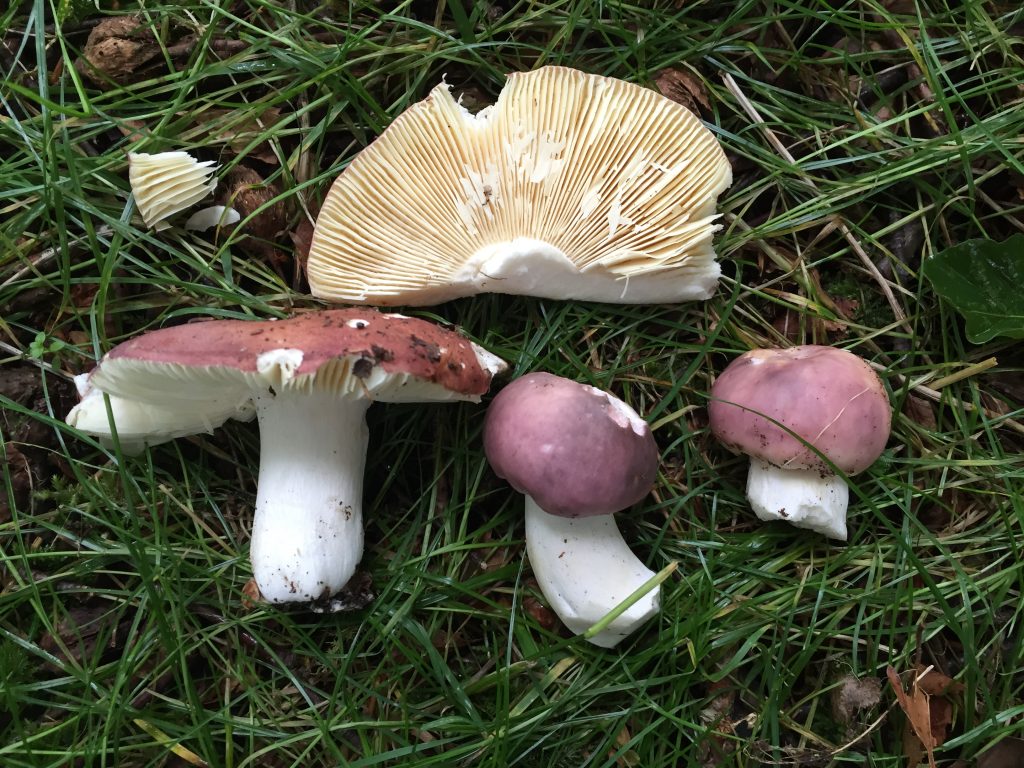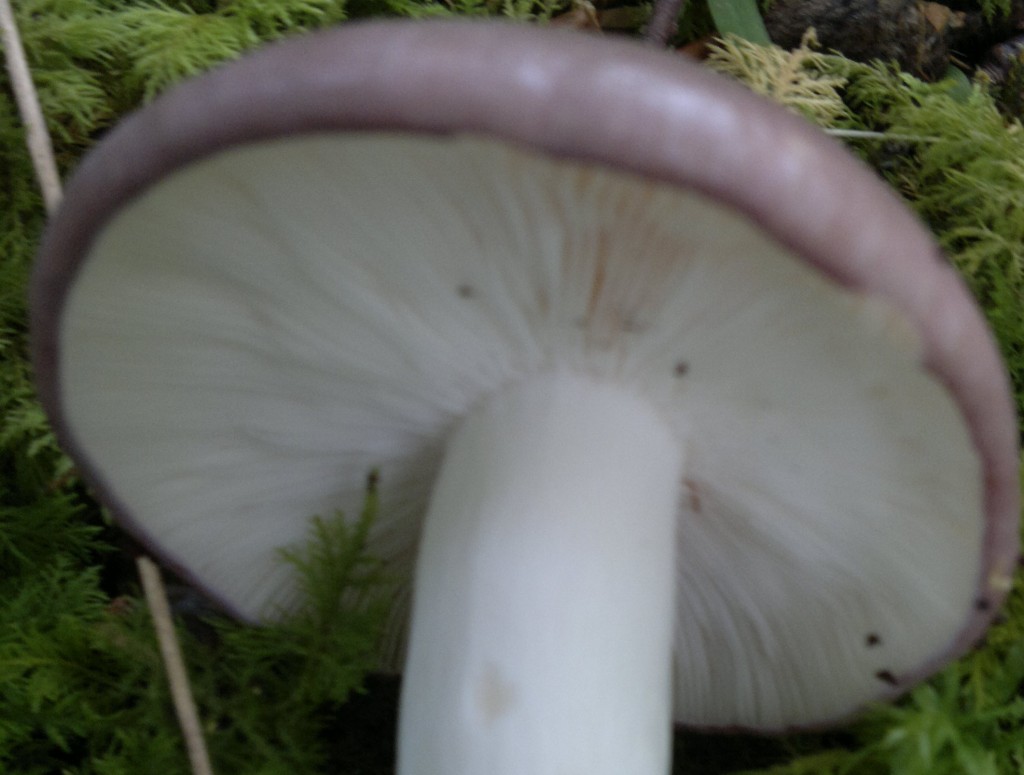Charcoal Burner – Edibility, Identification, Distribution
Russula cyanoxantha
- Edibility – 4/5 – An excellent firm-textured mushroom
- Distribution – 4/5 – Widely distributed and common in its habitat throughout the UK
- Identification – 3/5 – While there are several purple/greenish/grey capped brittlegills, the charcoal burner is the only one with greasy, non-brittle gills – though old specimens/dry weather can result in flakey gills (as in the mature specimen in the picture above). The taste is pleasantly mushroomy, with no bitterness (see below for information on using taste as an aid to ID). Cap colour: Variable, usually mostly purple, but often with blue, grey, green and occasionally yellowish hues. Be aware that there are several russula varieties that can have similar colours – none are dangerously toxic and the taste test will help reveal their true nature. Cap shape: Starting rounded, becoming flattened, occasionally upturned. Gills: Crowded, white, not crumbly (pliable and slightly greasy). White spores. Stipe: White, quite a crumbly texture when squashed. NEVER any hint of a ring.
- Habitat: Common under deciduous trees, usually, but by no means exclusively, beech.

Colour variants in charcoal burners – from my “20 Mushrooms” Webinar
For those struggling to get to grips with mushroom identification, and even those with a fair bit of experience, the russula (also known as brittlegill) family of mushrooms can be very daunting. It contains over 200 species, all of which have more or less the same characteristics – pale brittle gills, white/cream coloured spores and squat crumbly white stipes. They are beautiful mushrooms that really illuminate the forest floor – most sport colourful caps from yellow to reds to greens to blues and purples. Many different species can share the same cap colour however, so close observation of cap shape, habitat, smell and taste are key to accurate identification without a microscope.
Using taste to help identify a mushroom may seem counter-intuitive in a world where potentially killers lurk, but if you are certain you are dealing with a variety of brittlegill (russula spp.), and if you only taste (as opposed to eat) a tiny amount on the tip of your tongue, you wont come to any harm. Most russula are simply inedible. A few will give you a tummy upset. None are deadly.
You should not use taste to identify mushrooms (or pick any white gilled mushrooms for the pot) unless you can confidently eliminate the amanita family from your enquiries – see my posts on death cap, destroying angel, fly agaric, and blusher to learn the key characteristics of this group.
With that in mind, all the good edible varieties of russula actually taste pleasant, with a crisp texture, often nutty flavour and no bitterness. Don’t take half the lesson here and go around tasting all mushroom species – i’m told some deadly amanitas taste quite pleasant!
I recommend beginners focus their russula hunting on the charcoal burner and use taste as their final corroboration of their find. As the best of the edible russula, it is most easily distinguished by its pliable (ie. not crumbly) gills. That’s right…a brittlegill without brittle gills. Mushrooms are contrary like that!

Charcoal burner infographic from my “20 Mushrooms” Webinar
Related posts:


8 Comments
Russulas are a fantastic eating mushroom with a wide range of variety (200+ I believe), the good news is that there is no deadly poisious one here in the UK. Even the charcoal burner can come in a different cap colour as it would be expected.Russulas can come in all colours of the rainbow and in some cases you would need a microscope to identify a peticular species. I find the red coloured Russulas the most challenging, as they are very similar good and not good.I just lick the gills, the ones that can you give stomache upset are the ones that burns on your tongue and are very sharp. There are some very good eating ones that are a little sharp on your tongue, but will disappear with cooking. Also if you have a couple bad ones in your pot of plenty, it will not hurt you.
Best of luck with Russulas
Interesting point about the connection (or lack of) between tastiness and toxicity.
We sort of assume that toxic things will always taste unpleasant, maybe as a result of the natural evolution of our tastes- fly agaric are pretty toxic (and hallucinogenic), but taste delicious, in my limited experience.
I just want to ask if some of you has heard this kind of shroom called Psilocybe Caerulipes also know as Blue-Foot? I was reading some articles about this kind shrooms before engaging my self for the first time. Like this one from:https://www.trufflemagic.com/blog/psilocybe-caerulipes/ .They say that it has a very potent effect on the brain and hallucination. Unlike other shrooms this one is less intense. In one article that I’ve read Psilocybe Caerulipes influences the prefontral cortex thats responsible for for differentiating thoughts, consequences of actions, and social control. Magic mushroom are use on reducing the symptoms of obsessive-compulsive disorder and anxiety. It can also help people to quit smoking and alcohol addiction. Some studies also suggest the property of magic shrooms/truffles can be useful for cancer patients. I would really want to hear other insights regarding this kind shroom and could possible be used as an alternative medicine Thanks
Hi Daniel,
I hadn’t heard of P.caerulipes before, but am aware of several other psilocybe species, their benefits and potential pitfalls. If you are new to using psychoactive fungi medicinally or recreationally, the trip advice listed on the page you supplied is good. Also, dosage (as with all foods/drugs/medicines) is key. Microdosing is quite fashionable just now – worth looking into. I grew up around people who would take 100’s of liberty caps in one sitting, which i’d equate to downing a whole bottle of whisky in one go – potentially troublesome! (Not that I haven’t done it and survived!) Working out the right dose for you, and your purposes is key. My advice would be to start small, take breaks (its possible to develop short-term resistance to the effects of psilocybes, so dosing, say, on consecutive days, can reduce the effect) build up, and reduce dosage, until you work out what works for you. I hadn’t heard of anti-cancer properties yet in psilocybes, but many other fungi have been proven to be useful in this area – e.g..chag, turkey tail.
Take care
Mark.
I’m new to mushroom hunting, but have successfully harvested several Russula specimens for eating. I wonder if anyone uses the stipes in cooking? The caps come out great, but it would seem the stipes would need a longer/different cooking time
Hi Steve,
The stipes of russulas can be cooked and eaten in much the same way as the caps. There are a few mushroom families (notably leccinum and collybia) where the stipes tend to be tougher/harder to digest, and might benefit from different treatment, but not the russula family.
Mark.
Yesterday I ate some of these and today I feel ill, I vomited this morning. But there is no doubt it was these in the pictures, I even used the phone app.
I cooked them and the amount was small, maybe it was something else, but I am perplexed, is it possible there are different toxicities for different people.
Yes, certainly different people can react differently to different foodstuffs. Also there are about a dozen brittlegills that can look more or less the same as charcoal burners, and I wouldn’t trust a phone app to tell them apart.
See here for a discussion on phone ID Apps: https://gallowaywildfoods.com/plant-and-fungi-identification-apps-careful-now/
See here for a discussion of “The Spectrum of Edibility”: https://gallowaywildfoods.com/the-day-i-ate-a-deadly-plant-the-spectrum-of-edibility/